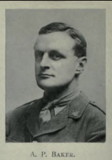2nd Lt
Albert Parkes Baker
Information about birth
|
Date of birth: 16/01/1886 |
|
Place of birth: Old Monkland, Lanarkshire, Scotland, United Kingdom |
General information
|
Last known residence: 5, Ettrick Road, Edinburgh, Scotland, United Kingdom |
|
Profession: Rubber Worker |
Army information
|
Country: England, United Kingdom |
|
Force: British Expeditionary Force |
|
Rank: Second Lieutenant |
|
Service number: / |
|
Units: — Highland Light Infantry, 3rd Bn. attd. Durham Light Infantry, 10th Bn. (Last known unit) |
Information about death
|
Date of death: 22/08/1917 |
|
Place of death: Inverness Copse, Belgium |
|
Cause of death: Killed in action (K.I.A.) |
|
Age: 31 |
Cemetery
|
Tyne Cot Cemetery Plot: 46 Row: G Grave: 12 |
Points of interest 3
| #1 | Place of birth | ||
| #2 | Last known residence | ||
| #3 | Place of death (approximate) |
My story
Albert Parkes Baker was born on 16 January 1886 in Old Monkland (now Coatbridge), Lanarkshire, Scotland. He was the son of Ada Bennett and Thomas Baker. Before the war, he had worked as a rubber worker in Kajang, Federated Malay States (present-day Malaysia). During the First World War, he joined the British Army and was assigned to the 3rd Battalion, Highland Light Infantry. Later, he was transferred to the 10th Battalion, Durham Light Infantry. In 1916, he married Margaret Muirhead in Edinburgh.
Second Lieutenant Albert Parkes Baker was killed in action on 22 August 1917, at the age of 31, during the Battle of Passchendaele.
On 21 August 1917, the men of the 10th Battalion, Durham Light Infantry were positioned at Zillebeke Bund, near Zillebeke Lake. At 02:00 on 22 August, the various companies moved towards the front line, advancing from north of Clapham Junction to near Stirling Castle. By 05:00, the battalion was in position. One company was to hold the front line while the attack commenced, a second company remained in reserve in the Menin Tunnel, and a third company joined the assault to form a defensive right flank.
At 07:00, the attack began with the objective of capturing the Gheluvelt Plateau. The Germans did not launch a heavy bombardment, and the old British front line was quickly taken. The leading platoon then advanced towards Herenthage Chateau. The platoon suffered heavy losses (only one officer and two soldiers returned) but succeeded in capturing 50 prisoners. Around 08:50, two platoons from the reserve advanced towards Inverness Copse to support the Somerset Light Infantry and the Duke of Cornwall's Light Infantry, who were also participating in the assault. At 11:00, A Company was sent to the western part of Inverness Copse. Additionally, three platoons were sent to the starting positions of the attack to occupy them in support. Later, these three platoons were also directed towards Inverness Copse. These positions were held for the remainder of the day. In the following two days, heavy fighting continued to secure Inverness Copse, which remained largely in British hands.
Between 22 and 24 August, the 10th Battalion, Durham Light Infantry suffered 53 killed, 205 wounded, 57 gas casualties, and 54 missing. Among the fallen was Albert Parkes Baker. His body was found after the war at Inverness Copse and reburied at Tyne Cot Cemetery, Plot 46, Row G, Grave 12.
Second Lieutenant Albert Parkes Baker was killed in action on 22 August 1917, at the age of 31, during the Battle of Passchendaele.
On 21 August 1917, the men of the 10th Battalion, Durham Light Infantry were positioned at Zillebeke Bund, near Zillebeke Lake. At 02:00 on 22 August, the various companies moved towards the front line, advancing from north of Clapham Junction to near Stirling Castle. By 05:00, the battalion was in position. One company was to hold the front line while the attack commenced, a second company remained in reserve in the Menin Tunnel, and a third company joined the assault to form a defensive right flank.
At 07:00, the attack began with the objective of capturing the Gheluvelt Plateau. The Germans did not launch a heavy bombardment, and the old British front line was quickly taken. The leading platoon then advanced towards Herenthage Chateau. The platoon suffered heavy losses (only one officer and two soldiers returned) but succeeded in capturing 50 prisoners. Around 08:50, two platoons from the reserve advanced towards Inverness Copse to support the Somerset Light Infantry and the Duke of Cornwall's Light Infantry, who were also participating in the assault. At 11:00, A Company was sent to the western part of Inverness Copse. Additionally, three platoons were sent to the starting positions of the attack to occupy them in support. Later, these three platoons were also directed towards Inverness Copse. These positions were held for the remainder of the day. In the following two days, heavy fighting continued to secure Inverness Copse, which remained largely in British hands.
Between 22 and 24 August, the 10th Battalion, Durham Light Infantry suffered 53 killed, 205 wounded, 57 gas casualties, and 54 missing. Among the fallen was Albert Parkes Baker. His body was found after the war at Inverness Copse and reburied at Tyne Cot Cemetery, Plot 46, Row G, Grave 12.
Sources 4
|
10 Battalion Durham Light Infantry (The National Archives, KEW (TNA), WO 95/1908/1). https://nationalarchives.gov.uk Sources used |
|
1891 Scotland Census (National Records of Scotland, Edinburgh (NRS), Reels 1-409). http://Ancestry.com Sources used |
|
1901 Scotland Census (National Records of Scotland, Edinburgh (NRS), Reels 1-446). http://Ancestry.com Sources used |
|
Scotland, National Probate Index (Calendar of Confirmations and Inventories), 1876-1936 http://Ancestry.com Sources used |
More information 3
|
Commonwealth War Graves Commission Database https://www.cwgc.org/find-records/find-war-dead/casualty-details/461797 |
|
Namenlijst (In Flanders Fields Museum) https://namenlijst.org/publicsearch/#/person/_id=e36d1177-0f6e-451c-9e03-79df137e3b4a |
|
Lives of the First World War (Imperial War Museum) https://livesofthefirstworldwar.iwm.org.uk/lifestory/138732 |
